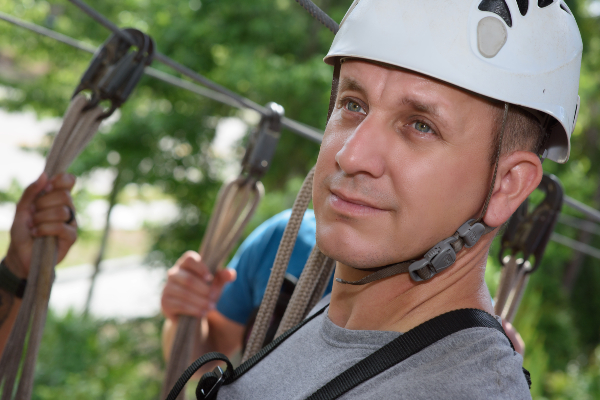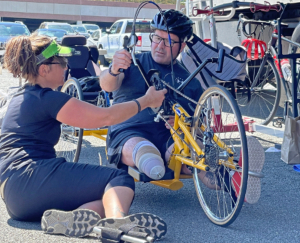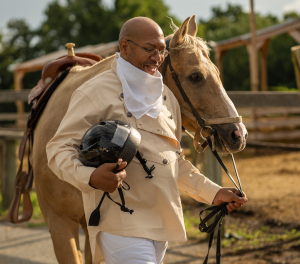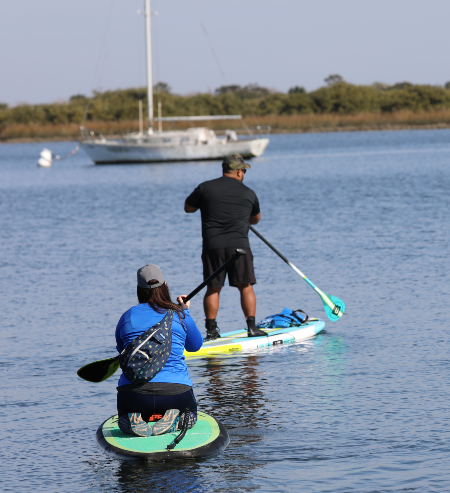Adventure Awaits: 5 Ways to Harness Physical Activity to Improve Veteran Mental Health

It's common to hear veterans express fondness for an adrenaline rush. Adrenaline is often a necessity as servicemen and women train and serve in combat.
Wounded Warrior Project® (WWP) works to harness thrill-seeking behaviors for healing – leading to positive outcomes for warriors.
Marine veteran James Rivera is familiar with the need for that adrenaline rush.
“War can do that; although I consider my four years in the U.S. Marines as the best years of my life," James said.
“It’s the camaraderie you have in the Marines that gets you through the trauma, the stress, and the intensity,” James said. “When I finally came home, the camaraderie was gone, but the trauma lingered.”
Back stateside, James felt alone and depressed – until a friend handed him a brochure for WWP. Connecting with other veterans and sharing new bonding experiences were reinvigorating.
“I’m able to engage with life now and share that with other veterans,” James said, adding that at WWP events, “there’s no ‘getting to know’ others; it’s just an instant connection.”
Adventures that Lead to Instant Connections
WWP offers a variety of opportunities to help veterans and their family members connect with others like them and gain mental and physical benefits in the process.
Consider these five activities to boost adrenaline and build camaraderie:

.jpg)
- Bicycling. Soldier Ride® is a unique, multi-day riding event that helps warriors manage visible and invisible wounds. Warriors don’t ride alone during Soldier Ride – they move forward together as a unit, just like they did during their military service. Events use adaptive technology to help injured veterans get active pedaling or hand cycling while they build confidence.
In addition to traditional and adaptive road biking, warriors can participate in mountain biking and skills development camps that introduces them to cycling techniques, safety, and drills to build their understanding of the sport. The Soldier Ride program also offers online workshops that engage warriors in virtual coffee socials, riding challenges, cycling maintenance tutorials, and more.
- Equine-assisted therapy. Caring for and riding horses as a part of equine-assisted therapy is an experience many warriors are surprised to find they enjoy. It is integrated into WWP programs such as Warrior Care Network® and the Independence Program.
Air Force veteran Richard Daniel, who came back home with invisible wounds, including traumatic brain injury and post-traumatic stress disorder (PTSD), tried equine therapy through WWP’s Independence Program. “When I’m with the horse, the rest of the world disappears,” Richard said. “I’m talking with the horse and bonding with the horse.”

Air Force veteran Richard Daniel found equine-assisted therapy through WWP's Independence Program. Watch how warrior Richard Daniel benefits from equine-assisted therapy.
To connect more warriors and families to equine therapy, WWP also works closely with PATH International, an organization that certifies facilities to provide professional one-on-one equine-assisted experiences. PATH locations incorporate mental health into their services, as well as occupational and speech therapy. Globally, beyond WWP, PATH’s expertise is shared with 6,000 veterans each year. - Riding motorcycles. There is something about a motorcycle and the open road that brings both a rush and peace. Through Rolling Project Odyssey, WWP brings together adventure-based learning and mental health coping skills, while expanding warriors’ support network. “Whether on wheels or on foot, veterans receive the same insights and learn from the same curriculum as they would on any Project Odyssey,” said Ryan Kules, WWP Project Odyssey director.
- Skiing and Snowboarding. In addition to the camps and traditional Soldier Ride events held during warmer weather, WWP’s ski and snowboarding skill training events help introduce the healing effects of being active in the snow. In these classes, injured warriors learn how to descend and stop safely, turn efficiently, and ride safely on the caterpillar and chair lift. Many of them experience snow for the first time, and no matter how adventurous, there are ample opportunities to form bonds with other veterans.
- Water sports. From kayaking to fishing and surfing to swimming with whale sharks and dolphins, WWP offers warriors opportunities to heal through water adventures. While stress from combat situations may still be close to the surface, water activities can bring relaxation and exhilaration.
Whether through a one-time connection event or a structured program, WWP warriors have many opportunities to experience life-enriching activities that combine camaraderie and adrenaline. For some, a newfound love of competition leads them to embrace advanced adaptive sporting opportunities, including participation in annual events like the Warrior Games.
How Adventures Can Lead to Healing
According to the 2022 Annual Warrior Survey, the strongest predictor of poor quality of life is depression. Three in every four warriors (74%) report experiencing depression, and 78% report feeling isolated. The analysis also shows that social support is associated with lower rates of suicidal thoughts.
WWP surrounds warriors and families with social support and activities that combine physical health and wellness, and mental health.

The link between physical and mental health is a recurring theme. For instance, in 2023, 52% of warriors who have participated in WWP’s physical health and wellness events experienced improvement in their mental health and emotional health.
“The evidence is irrefutable that physical activity reduces depression, improves mood, lowers stress, and decreases the use of prescription medication,” said James Herrera, vice president of physical health and wellness programs at WWP.
“You get an even greater impact when doing activities that put you in what we’d call a state of flow – an experience that has you so focused on the task at hand, nothing else can enter the mind,” James said. “Imagine buzzing down a mountain bike trail with the trees on either side, the wind in your face, and having to navigate around roots and rocks. Activities that create this hyper-awareness allow us to disconnect from the day-to-day and anything that may be weighing us down. It’s incredibly impactful and cost effective.”
“Some of our favorite activities to introduce to warriors are mountain biking, snow skiing and snowboarding, archery, rock climbing, and water sports,” James added. “Yes, there might be an element of adrenaline associated with those activities, but it’s not necessarily the adrenaline that’s the benefit. It’s the heightened state of mindfulness someone can experience. Add to that the benefit of finding flow in the outdoors – there’s an abundance of research on what being in nature does for our mental health.”
The activities listed here are part of WWP programs for post-9/11 warriors and their family members. For information, please contact the WWP Resource Center.
If a program is not immediately available, a warrior may be referred to a partner organization offering a similar program.
- Learn more about WWP's mental health services for veterans.
- Learn more about WWP’s physical health and wellness programs.
Contact: Cynthia Weiss – Public Relations, cweiss@woundedwarriorproject.org, 904. 738.2589
About Wounded Warrior Project
Since 2003, Wounded Warrior Project® (WWP) has been meeting the growing needs of warriors, their families, and caregivers — helping them achieve their highest ambition. Learn more.